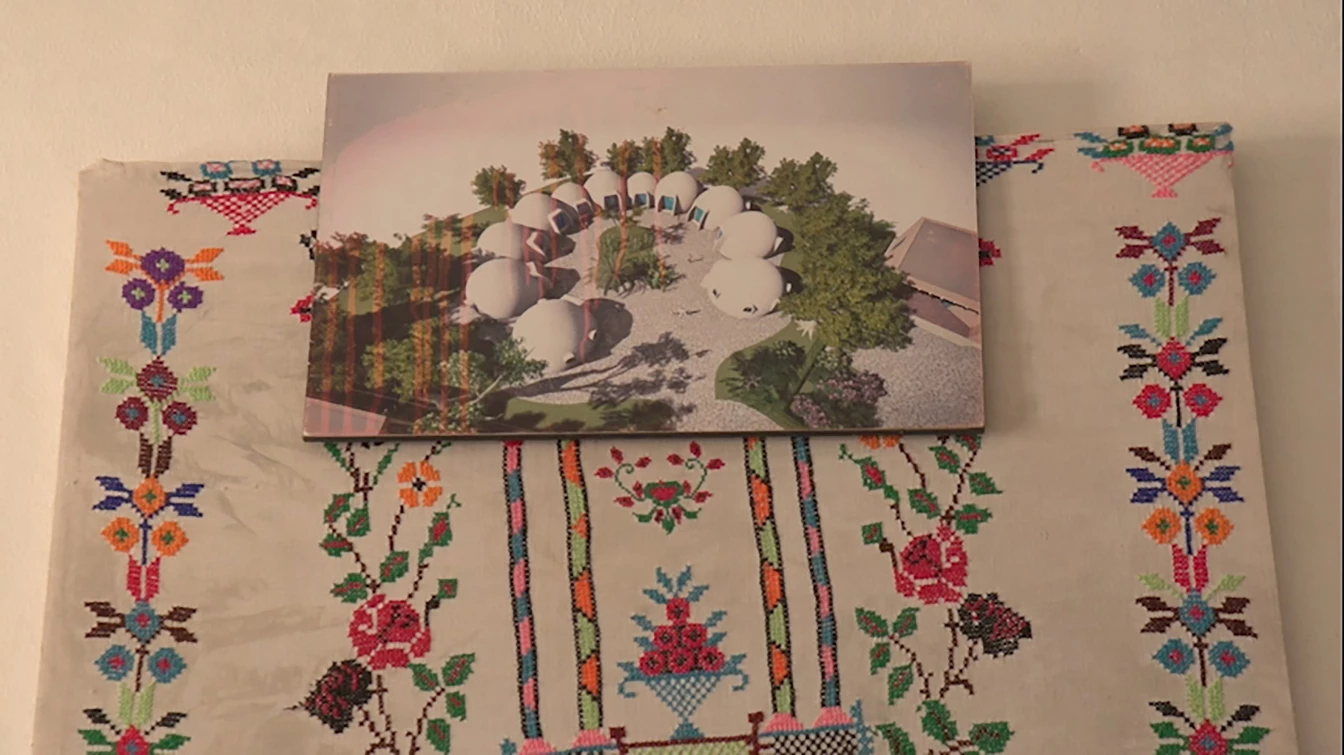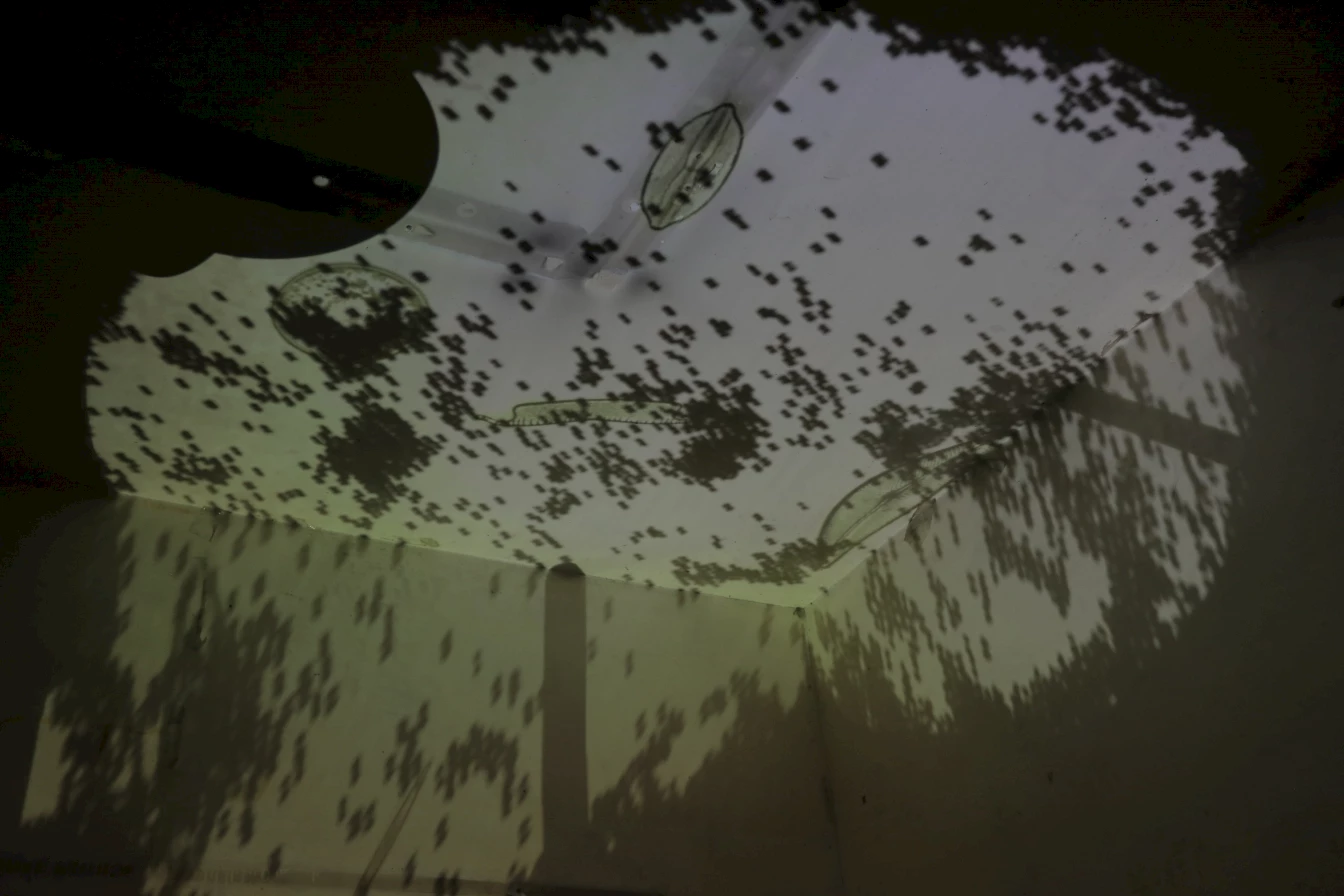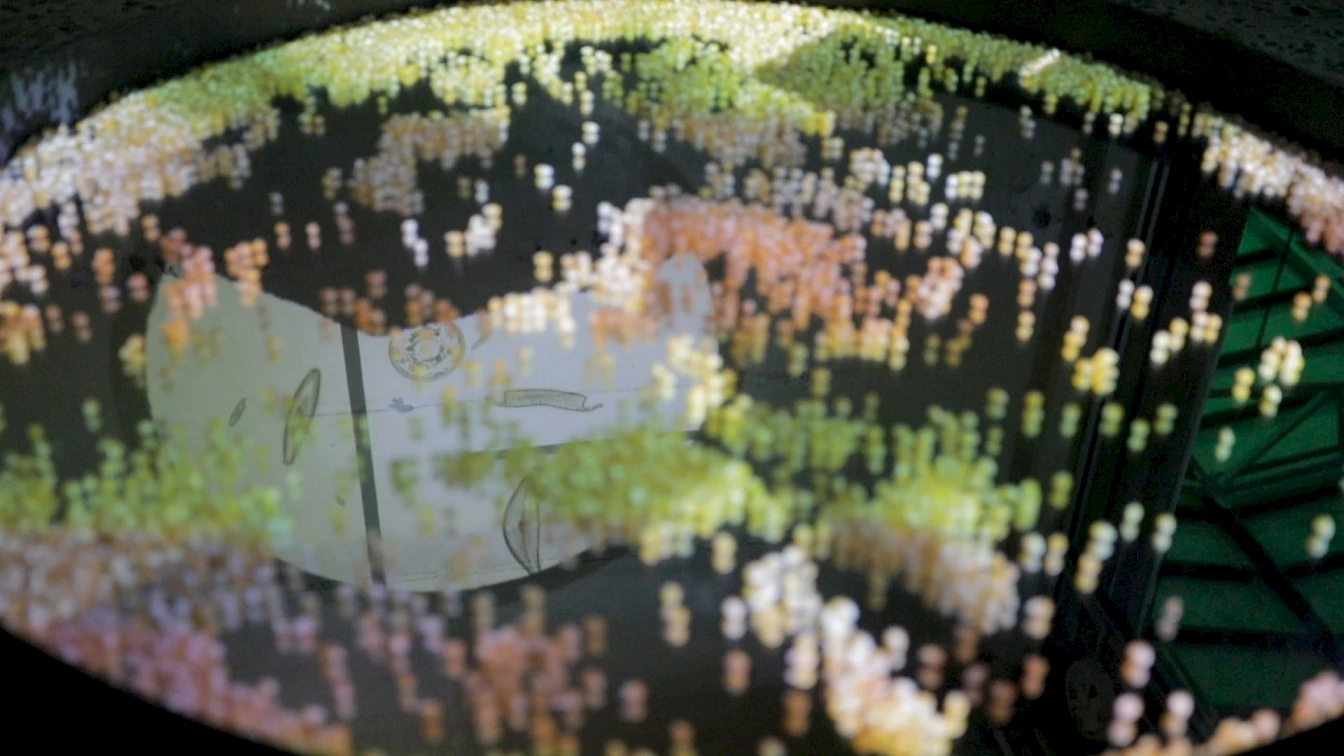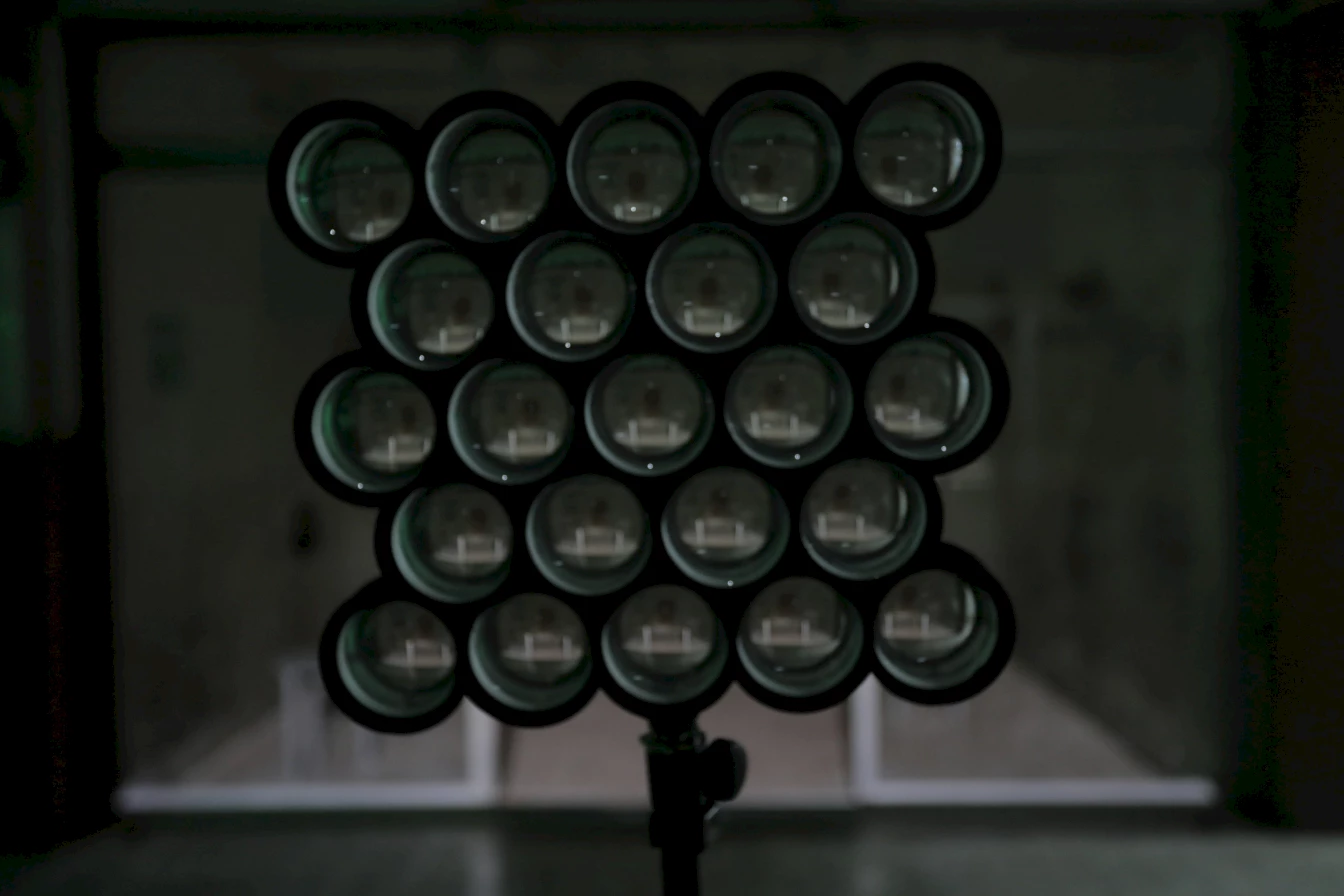
Still from Who Is Afraid of Ideology? Part 2 (2019).
If we think about ‘utopia’ away from its definition as an idyll, an image of an elsewhere linked to the desire for territorial expansion, let us attempt to think about it in the present, in the making – this is far from an idyllic image. This will entail stepping into the space of political action, while carrying within oneself the imagination, the ideologies, the politics one seeks to practice. It will involve entering the political field and not only watching it from a distance. The drive towards utopia can, of course, only be a collective movement, otherwise we linger inside a capitalist utopia – linger inside the slick, polished image.
I will attempt here to think through the image of utopia, the way it is produced and drawn, and the way it produces the political unconscious, affects it and is affected by it. I will think through a few ecological feminist projects that deal with such questions of land repossession and the manner with which they perform a certain utopian aspiration. These projects were forced to reimagine utopia, because of a direct threat to a community’s survival, whether a situation of war or targeted murder.
From Heterotopia(s) to Utopia(s) – Image Concrete
Being a child of the 1980s and an adolescent during the 1990s as a young adult I looked for an experience of utopia in smaller communities and avoided confrontation with the wider political sphere; in fact, I imagined that the only possibility for the utopian moment lay in the retrieval or retreat from society. Perhaps this relates to the ideals of modernism, or even the 1960s North American/North European experiments of living in libertarian, egalitarian communes. Although these were in absolute contradiction with my own reality and immediate surroundings, somehow together they became my dominant utopian image and it took some time to break away from it.
I have always viewed myself as a hyper-urban subject. I grew up in Beirut and witnessed its reconstruction over the 1990s. Once a no man’s land the city quickly turned into a haven for neoliberal urban experiments, based on property dispossession and expropriation. Nevertheless, I fantasised about, and probably fetishised too, the utopian idyll as being a calm, faraway ‘green retreat’ – I was performing the neoliberal imagination at its best. This projection was more than likely a way to avoid the political paralysis Lebanon had been dealing with over two generations, along with the fear of yet another political failure.
My first encounter with political organising in the broader sense was through a feminist organisation. It had become obvious to me that I had to step outside the drawn limits of the arts, culture, academia. However, here, I was also met with a certain establishment: in this case, a hegemonic feminism that had been promulgated mostly through NGOs, those institutions founded on individual rights and other identitarian discourse produced in the post-war period. This was, of course, not so straightforward. The post–Cold War political subject has more often been built on a mix of ideologies in conflict with one another. And so, in turn, was my feminist political consciousness.
I did experience the materialisation of utopia in other separatist feminist movements later on. But again, I faced nothing but contradictions. To accept political disappointments and the accumulation of defeats, whether inherited or directly experienced, is all part of building the utopian image. With every utopian imaginary comes the dystopic. They are dialectically entangled: the possibility of dystopia is embedded in every attempt at imagining utopia. I soon realised that inhabiting the contradictions was the only way forward. Whether initiating a cultural project for the few, running away to a commune, or attempting to establish feminist politics inside the institution – the most reformist move – I was stepping outside the harshness of the urban, capitalist environment, but also the field of politics. So small communal experiments ceased being the only parameter for me. This is when a new utopian image surfaced.
Utopia has had differing meanings. It once referred to a mass movement that takes over a place, a territory, a country, yet without the acknowledgement of slipping into a dystopic situation. Later, the term was used for political projects, such as socialism formed in the nineteenth century. Today, I ask, what would a feminist socialist utopia come to mean? Could we delve into this imagination? Would it occur on a large scale? How could such autonomous zones be organised? Could we think about this utopic imagination outside of the drive for property and the repossession of land and territory (seen even in the case of the commune)?
To imagine utopia is to enter into fiction, of economics, politics, social arrangements and agreements. It is a literary act in itself. It also relates to a very concrete, legal act of drafting a social contract, as evident in social realism. An act of writing and an act of planning, which means ‘drawing’. Let us also add ‘science’, in the feminist tradition of science-fiction novels, those written about a world either free of men or with dystopic predictions for the future. With both these strands of science fiction and social realism, perhaps it could be possible to imagine this feminist utopia expanding into a wider social sphere and reshaping social relations outside of capitalist relations of production and society.

Still from Who is Afraid of Ideology? Part 3 (2020); set concept and design by Vinita Gatne.

Still from Who is Afraid of Ideology? Part 3 (2020); set concept and design by Vinita Gatne.
The drawing, planning and construction of my own utopian image – made of soil, earth and concrete – first came from the experience of being at a women-only commune in Jinwar. The commune is built on repossessed land. And although it seems close to what a twentieth-century modernist utopia would look like in its architectural plan, the way the project is organised connects with a political life built around the notion of assembly. The commune also aspires towards producing a self-sufficient agricultural microeconomy, one that is in direct relation with the land and closely familiar with the lives of fauna and flora. The feminist plan for the commune came from the absolute need to survive in a situation of war. The ‘image concrete’ of the commune claims to tell the truth. But is it an image for what utopia could be (in the modern sense of a future projection)? Perhaps we should reframe the question and ask about the material upon which this utopian image is built, its maintenance and its changeability. What if the earth used to build the houses of the commune transformed with water and time? What kind of image would that become?
Utopia in the Making – Image Liquid or Image Mud
To build another utopia comes from the urgency of present conditions: the unsustainable economic system, for example. When the illusion of this apparently solid system melts into liquid, the solid image melts away too – in documentary terms, twenty-four frames per second dissolves. One must take advantage of this liquid moment in order to enter the matter of the liquid image. The utopian image. And its contradictions.
The making of the utopian image is a question of vision, optics and lenses. It is an image that is in movement. It has no fixed frames and so can be easily extended. It is an image of an abstracted landscape, produced in a situation of disarray and on the run. An image that multiplies and shapes itself according to the level of liquid or its lack. An image that absorbs its producers and transforms their hands, body, faces into its subject. An image that is shapeless, yet some solid entities can be identified on closer inspection. An image that unlike the solid documentary image cannot be identified and placed into a genre. The liquid image is heard and listened to in drops. It belongs as much to the realm of the unconscious as it does to consciousness. It also belongs to social media and the physical analogue world. It is a twirl. It gets stuck on a surface and then falls with a splash, leaving traces. The liquid image is a promenade. The liquid image belongs to many spaces at once. It also belongs to many ideologies that it adapts and adopts. It changes texture and colour; there is a formal change with every ideological shift.
This liquid image-to-come is an image in movement. And closer to the idea of utopia in the present it makes space for contradictions, mutations and voids. According to Newtonian physics the void is where there is an absence of matter, an absence of property and laws; it has no energy. Feminist theorist Karen Barad conversely states that in quantum physics, the vacuum is where particles are created; there is an inseparability between void and matter. The vacuum is not silence, it is speaking, it is murmuring, she says. It counters Newton’s concept, which was ultimately used as a colonial/capitalist expansionist excuse to reclaim and expropriate. It is a space of constant energy formation, a space to watch and listen to.
Utopia, too, can be a counter-expansionist project and build around the smallest entity, such as a seed or bacteria. When the smallest grain becomes the essential thing, utopia stops being a human-made plan or a human-made projection only. We start seeing the utopian image inside the earth, inside the ground, or underground. Rather than building the solid concrete image, we dig for it. Yet, in digging we do not extract. We watch the utopian image as it forms. It is made of small particles moving together in groups. An image from under the ground or what lies beneath. It is a reappropriation of territory by small entities and creatures.
Microcosmic Utopias – Image Bacteria, Image Seed
While walking through agricultural land in Tolima, south of Colombia, I came upon a site where a seed guardian was once murdered and so stopped to pay my respects. I noticed that what is now delineated as the scene of a crime is a space that cannot be fully seen nor captured by the camera lens; not that it cannot be framed, but that it cannot be captured. There is always a surplus of sight or a more than vision. Where a crime happens is indicated by the corpse itself, where the corpse fell and landed or where it was found. How the earth actually remembers this fall is different, however. It becomes a question of matter and material remembering: the way the murder has affected the soil. The effect of the fallen corpse on the soil spreads much wider than the surface marking of the crime. It also takes the form of bacteria and other living entities, to be seen under the microscopic lens. Departing from Hannah Landecker’s concept of the microcinematic image, we can perhaps think of the zoom lens as a tool to get closer to the soil of the crime site. The formations of bacteria that travel between body and soil are mainly invisible, but not only. If we think of the body as a bacterial mass, we no longer see it as having borders in the first place: the human becomes indistinct from its environment, and, more precisely, from its non-human environment. There is more life underground than there is on the surface of the planet, or in the air. This microbial dark matter of mysterious creatures consists mainly of bacteria and archaea; within each form are millions of distinct types, many of which are still to be discovered.
How to look through the zoom lens at a woman carrying a seed and explain why she has been working to conserve it? How to look again at the same woman in an agricultural field and show the smallest of dust particles which emerge from her working? How to dig for the formations of bacteria that rest inside that soil without disturbing its development and make an image for this? There is the macro and the micro lens, there is the mapping and the zooming out, there is the zooming in on the soil and the observation of the microorganisms within. There is the constant movement between. Between microscopic viewing and telescoping, macro framing and micro farming.

Still from Who is Afraid of Ideology? Part 3 (2020); set concept and design by Vinita Gatne.
It is undeniably cold murder that is linked to the struggles for land and seed autonomy of the Campesino movements in Central and South America. This much became starkly clear to me when I met Mercy Vera, a farmer from the Pijao Indigenous community in Tolima, along with Samanta Arango from Colombia’s Grupo Semillas and María Estela Barco Huerta, the general coordinator of DESMI, the most important association of Indigenous farmers in Chiapas. Barco referred to the fight for seed conservation and food sovereignty as ‘la guerra permanente y sistémica’ (the ongoing systematic war). She also said, ‘si los pueblos indígenas pierden, pierde el mundo’ (If Indigenous people lose, the whole world will lose). She talked about how this war is waged on the smallest things, the most essential things, such as corn seeds. Taking away the seeds deprives people of the basic right to nourishment; it deprives them of their right to be a peasant, forces them to migrate and to rely on industrial systems of food production.
Corn and native seeds are life that our ancestors bestowed upon us, and that we have to pass on to our children. Corn represents resistance and struggle. It has a heart, it has nutrients, and it is the healthiest thing we have.
A few years ago, Mercy Vera went to sleep every night thinking that she would be murdered. Many of her comrades had been killed by Colombia’s paramilitaries; everyone in her community expected to be next. ‘We Indigenous people live very close to our seeds’, she said. Seeds are history, they represent heritage, and they are proof of belonging to a certain community, to a place and to a land, as they are passed from one generation to the next. Seed autonomy is a threat for transnational corporations, governments and the paramilitaries. The reasons vary for each of these bodies, but significantly it is safety and, most importantly, self-sufficiency that seed banks give the peasants, which, in turn, can potentially lead to marginalising the state institution’s ‘legal apparatus’, the agribusiness of transnational corporations, and patent and genetically modified crops.
Samanta Arango from Grupo Semillas, an organisation that was established in Bogotá to ensure conservation and the sustainable use of biodiversity as well as collective human rights over territories and food sovereignty, added:
Once a Pijao woman told me that we have forgotten our language, but we will not give up our seeds. So, the seeds became like a symbol of resistance. The Pijao’s recuperation of their land was done through the seeds. Those lands were considered colonial guards. During the twentieth century the lands were divided in the aim of privatising them. Since the 1970s the Pijao have been taking back their land through seed recuperation. There is much resistance – groups like FARC were born there. Peasants are stuck in the middle of the war.
Arango works with different Indigenous communities throughout Colombia to assist in building seed banks. She also referred to the question of gender and of women as guardians in this process:
There is a very important figure for the Pijao community, which is Casica do lima, the seed guardian. She was considered a witch by the Spanish conquistadores. They thought that she was concealing a golden treasure. When they captured her, they discovered that it wasn’t gold but seeds. Before they killed her, she liberated the seeds in her territory.
Seeds, then, become the central element around which we can build another understanding of utopia. The smallest entities found inside the ground is the drive. One can imagine the tunnels, the under-image, the under-earth of the utopian image. Although we are forced to reimagine utopia because of the conditions in the present (survival, weather, the context of war, such as the women-only commune in Jinwar or targeted murder in Tolima), there is a feminist potential for its image at this time. It remembers land dispossession and is rebuilt on reappropriation, from the underground.
Bibliography:
Karen Barad, ‘Posthumanist Performativity: Toward an Understanding of How Matter Comes to Matter’, Signs 28, no. 3 (Spring 2003): 801–31.
Octavia E. Butler, Parable of the Sower (New York: Warner Books, 1993).
Hannah Landecker, ‘Creeping, Drinking, Dying: The Cinematic Portal and the Microscopic World of the Twentieth Century Cell’, Science in Context 24, no. 3 (2011): 381–416.
Ursula K. Le Guin, Always Coming Home (New York: Harper & Row, 1985).
Ursula K. Le Guin, The Dispossessed: A Novel (New York: HarperCollins, 1974).
Marge Piercy, Woman on the Edge of Time (New York: Fawcett, 1976).